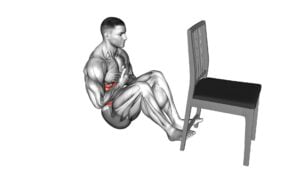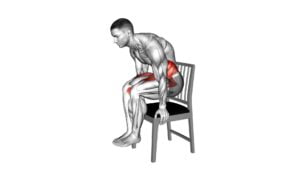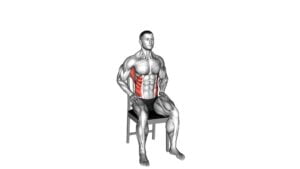Roman Chair Sit-Up – Video Exercise Guide & Tips

Looking to strengthen your core? Check out this video exercise guide and tips for the Roman Chair Sit-Up.
Watch This Exercise Video
With its focus on the second person point of view, active voice, and contractions, this concise introduction will provide you with the information you need to perform this exercise correctly and effectively.
Whether you're a beginner or advanced fitness enthusiast, this article has you covered with variations for different fitness levels and tips for increasing intensity.
Get ready to take your core workout to the next level!
Key Takeaways
- Roman Chair Sit-Ups are highly effective for building core strength and stabilizing the spine.
- They target abdominal muscles including rectus abdominis, obliques, and transverse abdominis.
- Proper form and technique, including engaging the core and maintaining a neutral spine, are crucial to avoiding lower back strain.
- Breathing techniques, such as exhaling forcefully during the lift and inhaling through the nose during the descent, can enhance stability and minimize strain on the lower back.
Benefits of Roman Chair Sit-Up
Discover the numerous benefits you can achieve by incorporating Roman Chair Sit-Ups into your workout routine.
This exercise is highly effective for building core strength and targeting your abdominal muscles. By engaging your core, Roman Chair Sit-Ups help to stabilize your spine and improve your overall posture. This is crucial for preventing lower back pain and injury.
Additionally, this exercise specifically targets your abdominal muscles, including your rectus abdominis, obliques, and transverse abdominis. Strengthening these muscles not only gives you a tighter and more toned midsection, but it also improves your functional strength and stability in everyday activities.
Roman Chair Sit-Ups also help to enhance your overall athletic performance, as a strong core is essential for optimal power and efficiency in movements. By incorporating this exercise into your routine, you can expect to see improvements in your core strength, abdominal muscle definition, and overall physical performance.
Now, let's move on to the next section and discuss the proper form and technique for executing Roman Chair Sit-Ups.
Proper Form and Technique
To perform the Roman Chair Sit-Up with proper form and technique, it's important to engage your core throughout the exercise. This helps to stabilize your body and prevent strain on your lower back.
Additionally, focusing on your breathing and using proper breathing techniques can further enhance stability and maximize the effectiveness of the exercise.
Core Engagement Importance
Ensure your core is engaged properly for maximum effectiveness and safety during Roman Chair Sit-Ups. Core engagement is crucial for maintaining stability and preventing strain on your lower back. By activating your core muscles, you create a strong foundation for the exercise, allowing you to perform the movement with control and precision.
Core stabilization is essential in this exercise as it helps protect your spine and maintain proper alignment. Engaging your abdominal muscles also contributes to building strength in your core, which can improve your overall fitness and posture. Remember to focus on contracting your abs and maintaining a neutral spine throughout the exercise.
Now let's move on to the next section, where we'll discuss how to avoid lower back strain during Roman Chair Sit-Ups.
Avoiding Lower Back Strain
To prevent lower back strain, consistently engage your core and maintain proper form and technique during Roman Chair Sit-Ups. Lower back injuries can occur if you don't properly engage your abdominal muscles and rely too much on your lower back during the exercise.
To avoid this, focus on contracting your abs and pulling your belly button towards your spine throughout the movement. This will help to strengthen your abdominal muscles and provide stability to your lower back.
Additionally, make sure to keep your back straight and avoid rounding or arching it during the sit-up. Remember to start with proper form and gradually increase the difficulty of the exercise as your core strength improves.
Breathing Techniques for Stability
Breathe rhythmically to maintain stability and proper form during Roman Chair Sit-Ups. Incorporating proper breathing techniques is essential for stability exercises like this one.
As you perform the sit-up, exhale forcefully through your mouth as you lift your torso off the chair. This exhalation helps engage your core muscles and stabilize your body.
Inhale through your nose as you lower your torso back down to the starting position. This rhythmic breathing pattern not only helps you maintain stability, but it also aids in maximizing your effort and minimizing strain on your lower back.
By focusing on your breath and maintaining a steady rhythm, you can enhance your overall performance and achieve better results.
Now, let's move on to exploring variations for different fitness levels.
Variations for Different Fitness Levels
Now let's explore some variations of the Roman Chair Sit-Up that cater to different fitness levels.
For beginners, modifications can be made by using a lighter weight or reducing the range of motion.
If you're more advanced, progressions can be added by increasing the weight or incorporating additional challenging movements.
Beginner Modifications
If you're just starting out with the Roman Chair Sit-Up exercise, you can modify it to suit your fitness level. Here are some beginner modifications and alternative exercises to help you get started:
- Bent Knee Roman Chair Sit-Up: Instead of keeping your legs straight, bend your knees and place your feet flat on the Roman Chair. This reduces the intensity and makes it easier to perform the exercise.
- Assisted Roman Chair Sit-Up: Use a resistance band or have a partner hold your feet down to provide assistance as you perform the sit-up. This can help you build strength gradually.
- Crunches: If the Roman Chair Sit-Up is too challenging, start with basic crunches on the floor. Lie on your back with your knees bent and feet flat on the ground. Lift your upper body off the floor, engaging your core muscles.
- Stability Ball Sit-Up: Sit on a stability ball with your feet flat on the ground. Perform a sit-up by leaning back and then coming back up. This exercise also helps to strengthen your core.
Advanced Progressions
Continue building on your progress with the Roman Chair Sit-Up exercise by exploring advanced progressions and variations suited to different fitness levels.
As you become more comfortable with the basic sit-up, you can challenge yourself with advanced variations to further strengthen your core muscles.
One advanced variation is the weighted Roman Chair Sit-Up, where you hold a dumbbell or a weight plate against your chest as you perform the sit-up.
Another option is the twist variation, where you twist your torso to the left or right at the top of the sit-up, engaging your oblique muscles.
For those looking for an extra challenge, the straight leg Roman Chair Sit-Up can be done by keeping your legs straight throughout the movement.
These advanced modifications will help you take your Roman Chair Sit-Up to the next level.
Common Mistakes to Avoid
To perform the Roman Chair Sit-Up correctly, ensure that you avoid these common mistakes:
- Using momentum: It's important to maintain control throughout the exercise. Avoid swinging your body or using momentum to lift yourself up. This not only reduces the effectiveness of the sit-up but also puts unnecessary strain on your lower back.
- Rounding your back: Keep your back straight throughout the movement. Avoid rounding your back as this can lead to discomfort and potential injury. Engage your core muscles and focus on maintaining proper form.
- Pulling on your neck: Instead of using your neck and shoulders to lift yourself up, focus on using your abdominal muscles. Avoid pulling on your neck as this can strain the muscles and lead to pain or injury.
- Neglecting breathing: Remember to breathe throughout the exercise. Inhale as you lower yourself down and exhale as you lift yourself up. Neglecting proper breathing technique can make the exercise more challenging and less effective.
Tips for Increasing Intensity
To increase the intensity of your Roman Chair Sit-Up and challenge your core muscles even further, focus on incorporating progressive overload techniques. One effective way to do this is by gradually increasing the resistance. Start by using your body weight as resistance, and as you become stronger, you can add additional weight by holding a dumbbell or a weight plate against your chest during the exercise. This added resistance will make your muscles work harder and promote muscle growth.
In addition to increasing resistance, it's also important to properly warm up before performing the Roman Chair Sit-Up. A proper warm-up routine will help prepare your muscles for the workout and reduce the risk of injury. Begin with some dynamic stretches such as leg swings and arm circles to warm up your entire body. Follow this with some light cardio exercises like jogging or jumping jacks to increase your heart rate and blood flow. Finally, perform a few sets of bodyweight sit-ups to specifically target your core muscles and get them ready for the more intense Roman Chair Sit-Up.
By incorporating progressive overload techniques and ensuring a proper warm-up, you can increase the intensity of your Roman Chair Sit-Up and maximize your core muscle development.
Now, let's move on to the next section and explore a sample workout routine with the Roman Chair Sit-Up.
Sample Workout Routine With Roman Chair Sit-Up
Start your sample workout routine with the Roman Chair Sit-Up by performing 3 sets of 10 repetitions, focusing on maintaining proper form and engaging your core muscles throughout the exercise. This exercise is a great way to strengthen your core and improve your overall fitness.
To make the most out of your workout, consider incorporating the following modifications and additional core strengthening exercises:
- Modify the intensity: If you find the Roman Chair Sit-Up challenging, you can start by placing your hands behind your head instead of crossing your arms over your chest. This will provide additional support and make the exercise slightly easier.
- Add resistance: Once you have mastered the basic form of the Roman Chair Sit-Up, you can increase the intensity by holding a weight plate or a dumbbell against your chest. This will add resistance and further engage your core muscles.
- Include other core exercises: To target your core from different angles, consider adding exercises like planks, Russian twists, and bicycle crunches to your workout routine. These exercises will help strengthen your abs, obliques, and lower back.
- Progress gradually: As you become more comfortable with the Roman Chair Sit-Up and other core exercises, gradually increase the number of sets and repetitions. This will challenge your muscles and help you continue to progress in your fitness journey.
Remember to always listen to your body and adjust the workout according to your fitness level. By incorporating these workout modifications and core strengthening exercises, you'll be well on your way to building a strong and stable core.
Frequently Asked Questions
Can the Roman Chair Sit-Up Help in Reducing Belly Fat?
Yes, the Roman Chair Sit-Up can help reduce belly fat.
By targeting your abdominal muscles, this exercise increases muscle strength and tone, which can lead to a reduction in overall body fat, including belly fat.
There are various variations of the Roman Chair Sit-Up that can further engage different muscle groups and intensify the workout.
Incorporating this exercise into your fitness routine can contribute to a more toned and defined midsection.
Are There Any Age Restrictions for Performing the Roman Chair Sit-Up?
There are age limitations for performing the roman chair sit-up. However, it's important to note that the benefits of this exercise for core strength can be enjoyed by individuals of all ages.
The roman chair sit-up targets the abdominal muscles and helps in strengthening the core. It's a challenging exercise that can be modified to suit different fitness levels.
Consult with a fitness professional to determine if the roman chair sit-up is suitable for your age and fitness level.
How Many Repetitions and Sets Should I Do for the Roman Chair Sit-Up?
For the roman chair sit-up, it's important to follow proper form and technique. When it comes to repetition and set guidelines, it's recommended to start with 2-3 sets of 10-15 repetitions.
As you become more comfortable and stronger, you can gradually increase the number of sets and repetitions. Remember to listen to your body and take breaks if needed.
Consistency is key for seeing progress and avoiding injury.
Can I Perform the Roman Chair Sit-Up if I Have Lower Back Pain?
Yes, you can still perform the Roman Chair Sit-Up even if you have lower back pain.
However, it's important to listen to your body and not push through any pain.
If the exercise exacerbates your lower back pain, it may be best to try alternative exercises that target the same muscles, such as planks or stability ball rollouts.
Are There Any Alternatives to the Roman Chair Sit-Up for Targeting the Same Muscle Groups?
Looking for alternative exercises to target the same muscle groups as the Roman Chair Sit-Up?
There are a few options you can try. Planks are great for engaging your core, while hanging leg raises work your abs and hip flexors. If you're looking for a more dynamic exercise, try Russian twists.
Conclusion
In conclusion, the Roman Chair Sit-Up is a highly effective exercise for strengthening the core muscles.
By maintaining proper form and technique, individuals can avoid common mistakes and maximize the benefits of this exercise.
Additionally, incorporating variations and increasing intensity can help individuals progress in their fitness levels.
By following a sample workout routine that includes the Roman Chair Sit-Up, individuals can achieve a stronger and more defined core.

Author
Years ago, the spark of my life’s passion ignited in my mind the moment I stepped into the local gym for the first time. The inaugural bead of perspiration, the initial endeavor, the very first surge of endorphins, and a sense of pride that washed over me post-workout marked the beginning of my deep-seated interest in strength sports, fitness, and sports nutrition. This very curiosity blossomed rapidly into a profound fascination, propelling me to earn a Master’s degree in Physical Education from the Academy of Physical Education in Krakow, followed by a Sports Manager diploma from the Jagiellonian University. My journey of growth led me to gain more specialized qualifications, such as being a certified personal trainer with a focus on sports dietetics, a lifeguard, and an instructor for wellness and corrective gymnastics. Theoretical knowledge paired seamlessly with practical experience, reinforcing my belief that the transformation of individuals under my guidance was also a reflection of my personal growth. This belief holds true even today. Each day, I strive to push the boundaries and explore new realms. These realms gently elevate me to greater heights. The unique combination of passion for my field and the continuous quest for growth fuels my drive to break new ground.







